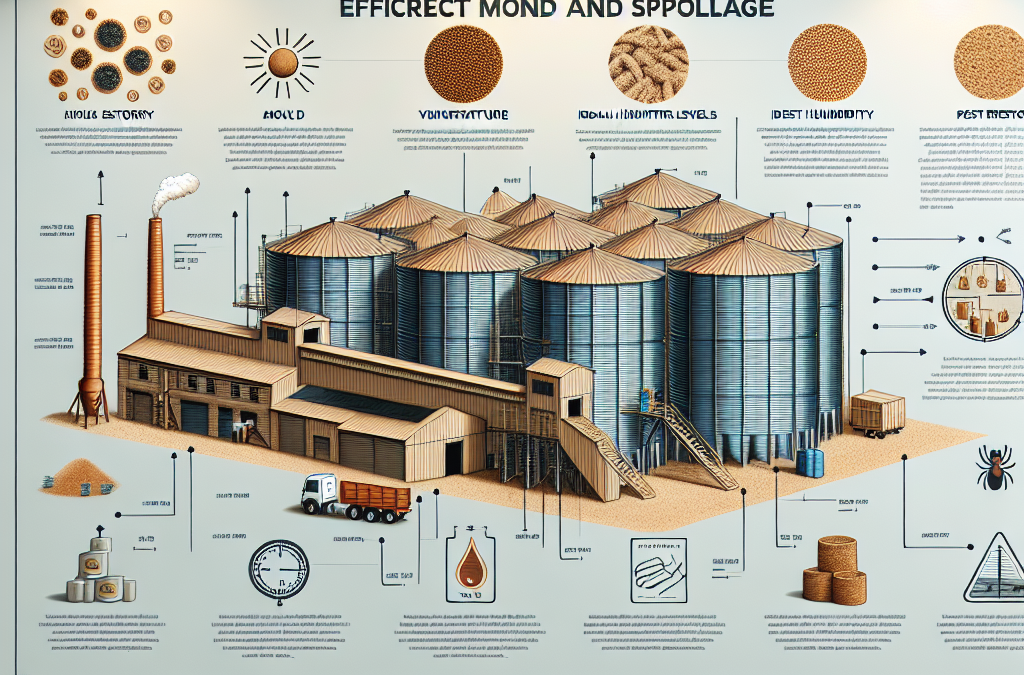Table of Contents
- Proper Ventilation in Grain Storage
- Monitoring Grain Moisture Levels
- Using Quality Storage Containers
- Regular Inspections and Maintenance
Proper Ventilation in Grain Storage
Understanding the Need for Airflow
Let’s talk airflow. Ensuring proper ventilation in your grain storage is, in my experience, crucial for preventing mold. Airflow helps to regulate temperature and moisture levels, which are both key players in the battle against spoilage.
Respecting the natural breathing process of grain is like watching a good ol’ football game. You don’t wanna miss a beat to keep ahead of the enemy—mold.
The trick is to balance it just right. Too much airflow, and you risk over-drying; too little, and it can become a sauna for mold spores. So, keep your fans and vents in optimum condition!
Choosing the Right Ventilation Equipment
Regular fans might not cut it in the grain world. From my barn to yours: investing in the right equipment will make a difference. Look for setups specifically designed for grain storage—big bang for your buck right there.
Top-notch systems are often a mix of air inlets, outlets, and specialized control mechanisms. They’re like the sophisticated gadgets you never knew you needed until you had ’em.
Sure, the initial cost can make the wallet groan, but considering the savings in reducing spoilage and maintaining quality, the long-run benefits are so worth it.
Maintaining the Ventilation System
Now, let’s get into a lil’ maintenance. It’s so easy to forget about upkeep when the system is quietly running in the background. But trust me on this: regular checks are the secret to extending its life.
Every season, get up there, clean out those fans, and check connections. Tell yourself it’s like tuning up your car–spend a little now to save a lot later.
If you’re anything like me, who has to remind himself to service his truck, set some calendar alerts or sticky notes to keep you in check. Keep the airflow constant and clean, and your grains will thank you.
Monitoring Grain Moisture Levels
Recognizing the Importance of Moisture Content
Man, if there’s one thing I’ve learned, it’s that moisture’s like finding pepper in your caramel. It’s all about balance. Not enough, your grains get dry and hard; too much, they become a breeding ground for mold.
Regularly checking the moisture content is just good practice. It’s like keeping track of your monthly budget—except with less math. Most grains thrive with a specific moisture range, so stick to it like a lifeline.
For wheat, corn, or barley—the main guys in my arsenal—the sweet spot’s typically around 12-15%. Go above or below that, and you could be in for some trouble.
Tools for Measuring Moisture
Investing in a reliable moisture meter was a game-changer for me. Think of it as a little insurance policy, securing the quality of your grains.
Moisture meters come in all shapes and sizes, and yes, skipping on the cheapies might just save you headaches later on. Believe me, read some reviews, and make a smart pick.
They’re easy to use, too! With each reading, you’re getting closer to ensuring that your grains are in their prime condition. It’s all about keeping it simple and effective.
Adjusting Conditions Based on Readings
Occasionally, those readings will let you know something’s up. From experience, let ’em guide you in tweaking your storage environment if necessary.
Sometimes, you’ll need to up the ante on ventilation to lower moisture or even dry out some grains if levels are especially high. Quick tweaks here will save major adjustments later.
Similarly, if it’s too low, a gentle misting can sometimes work wonders, but remember—it’s all about moderation. Trust your tools and instincts for the best outcomes.
Using Quality Storage Containers
Choosing the Correct Container Material
Not all containers are created equal, trust me. If you’re using the good ol’ “anything goes” approach that I used to follow, you might want to reconsider.
The ideal grain container is airtight and durable, often made from materials that resist corrosion and pests. My favorites are heavy-duty plastics or metals, they stand the test of time.
Rust or pests can flip your grain dream upside down faster than you can say, “I should have planned better.” So don’t skimp on quality in this area, it’s a surefire way to save yourself some grief.
Advantages of Sealed Containers
Sealed containers provide an excellent barrier against pests, moisture, and other unwanted guests—not too unlike a locked front door protects your home.
They’re fantastic for keeping everything fresh and out of the elements, which is a priority for long-term storage. A good seal keeps out humidity and those pesky rodents that would love a midnight snack.
A little heads-up, though: always check the seals for wear and tear. It’s like ensuring your windshield wipers are working during a storm. Be vigilant, and they won’t fail you when you need ‘em most.
Maintaining Containers
Here’s the lowdown—maintenance is key. After emptying your containers, I always give them a thorough cleaning and let them dry completely before refilling.
You’ll sleep easy knowing you’ve done your part to keep your grains safe and sound. Consider it like that little bit of extra TLC you put into everything that matters.
If you spot any damages or areas of potential pest entry, repair them immediately. It saves a ton of trouble down the line, and keeps everything in top-notch condition.
Regular Inspections and Maintenance
Performing Visual Inspections
Regular inspections can’t be overstated. It’s old school but super effective. A keen eye caught early signs of trouble more times than I’d like to admit.
Check your grains for unusual odors, changes in color, or signs of pests. It’s a quick walk-through that, in reality, packs a massive punch against spoilage.
A flashlight and a notebook are your best friends here. You’re looking for anything that doesn’t seem to belong. Think of yourself as a grain detective!
Scheduling Routine Maintenance
A little foresight goes a long way. Mark those calendars, because consistent maintenance checks can prolong the life of not only your storage equipment but the grains themselves.
It’s like remembering to water your plants. You do it regularly to prevent them from wilting. Same principle applies here – regular, planned efforts make all the difference.
Proactively addressing issues before they escalate is always preferable. Not only does your grain quality improve, but it spares you the panic of a major spoilage disaster.
Educating Staff or Family
If you’re working as a team, everyone’s got to know the drill. As they say, sharing is caring, and that rings true for storage tips and knowledge too.
Whether it’s family or crew, make sure everyone understands the importance of good storage practices and knows how to spot potential issues.
Empower everyone around you with knowledge, and those teamwork vibes will ensure no mildew or spoilage sneaks past unnoticed.
FAQ about Grain Storage
1. Why is ventilation important in grain storage?
Ventilation helps control moisture and temperature levels, preventing mold and spoilage by maintaining optimal conditions for grain storage.
2. What is the ideal moisture content for grains?
The ideal moisture content is usually between 12-15% for most grains like wheat, corn, and barley, to prevent spoilage.
3. What materials are best for grain storage containers?
Heavy-duty plastics and metals are often best for storage containers, as they’re durable and offer protection against pests and corrosion.
4. How often should I inspect my grain storage?
Regular inspections, ideally every season, are essential to catch early signs of mold, pests, or other issues before worsening.
Related Content
Auto Amazon Links: No products found.





